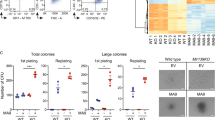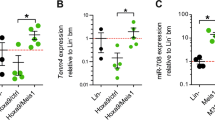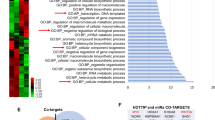Abstract
Bakground:
The EVI1(ecotropic virus integration site 1) gene codes for a zinc-finger transcription factor, whose transcriptional activation leads to a particularly aggressive form of acute myeloid leukaemia (AML). Although, EVI1 interactions with key proteins in hematopoiesis have been previously described, the precise role of this transcription factor in promoting leukaemic transformation is not completely understood. Recent works have identified specific microRNA (miRNA) signatures in different AML subgroups. However, there is no analysis of miRNAs profiles associated with EVI1 overexpression in humans.
Methods:
We performed QT-RT–PCR to assess the expression of 250 miRNAs in cell lines with or without EVI1 overexpression and in patient samples. We used ChIP assays to evaluated the possible binding of EVI1 binding to the putative miRNA promoter. Proliferation of the different cell lines transfected with the anti- or pre-miRs was quantified by MTT.
Results:
Our data showed that EVI1 expression was significantly correlated with the expression of miR-1-2 and miR-133-a-1 in established cell lines and in patient samples. ChIP assays confirmed that EVI1 binds directly to the promoter of these two miRNAs. However, only miR-1-2 was involved in abnormal proliferation in EVI1 expressing cell lines.
Conclusions:
Our data showed that EVI1 controls proliferation in AML through modulation of miR-1-2. This study contributes to further understand the transcriptional networks involving transcription factors and miRNAs in AML.
Similar content being viewed by others
Main
The human EVI1 (ecotropic virus integration site 1) gene is located on 3q26.2, a region frequently rearranged in acute myeloid leukaemia (AML) (Wieser, 2007). Most patients with 3q26 rearrangements overexpress EVI1. However, its expression is also elevated in about 10% of AML patients with no 3q aberrations, as a result of so far unknown mechanisms (Wieser, 2007). Of importance, EVI1 overexpression associates with poor prognosis and a shorter survival in AML (Nucifora et al, 2006).
MicroRNAs (miRNAs) are small non-coding RNAs that negatively regulate gene expression by repressing translation or inducing sequence-specific degradation of target mRNAs (Bartel, 2004). MicroRNAs play important roles in numerous cellular processes including hematopoiesis (Shivdasani, 2006; Lawrie, 2007; Fatica, 2006 no. 13). Over the past 3 years, several groups have described miRNA signatures associated with recurrent cytogenetic, molecular aberrations and with outcome in AML (Fabbri et al, 2008). However, anything is known about a miRNA profile in human AML patients with 3q26 rearrangements or EVI1 overexpression. It has been reported that miRNA regulation is mediated by lineage-specific transcription factors involved in the developmental and differentiation processes (Bartel, 2004; Choong et al, 2007; Fazi et al, 2005). Interestingly, EVI1 and miRNAs have important roles in development and cell differentiation (Perkins et al, 1991). In this study, we establish a miRNA signature in AML that could be possibly regulated by overexpression of EVI1. We found a strong positive correlation between the expression levels of EVI1 and clustered microRNAs miR-1-2/133a-1 in AML cell lines and in patient samples. We demonstrated that EVI1 binds to a region upstream of the miRNA cluster resulting in an upregulation of miR-1-2/133a-1. Furthermore, functional studies showed that expression of miR-1-2 was associated with enhanced proliferation in AML.
Materials and methods
Cell lines and patient samples
Cell lines MUTZ-3, TF-1, F-36P, HEL, HL-60, NOMO-1, MOLM-13, and OCI-AML2 were maintained in RPMI-1640, supplemented with 1% penicillin-streptomycin, and 10% FBS (GIBCO-BRL, Grand Island, NY, USA); 10 ng ml–1 GM-CSF was added in MUTZ-3, TF-1, and F-36P. P19 cell line was maintained in αMEM, supplemented wit 10% FBS. Patient samples were collected from the Department of Genetics, University of Navarra, Spain (Supplementary Table 1). Leukaemic blasts were obtained from bone marrow of AML patients with more than 60% blasts. The study was carried out in accordance with the ethical guidelines of our institution.
Quantitative RT–PCR (qRT–PCR) of mRNA and miRNA levels
Quantitative RT–PCR was carried out with ABI Prism-7500 (Applied Biosystems, Foster City, CA, USA) with 20 ng of cDNA using TaqMan gene expression assays for EVI1 (Hs01118675_m1) and human GAPDH (Hs99999905_m1). Overexpression of EVI1 transcript was defined as levels higher than the average of seven bone marrow samples from healthy volunteers and three times the standard deviation. For miRNA quantification, qRT-PCR was performed with 10 ng of total RNA using either the TaqMan miRNA Human Panel Assay Set (ED000298) or TaqMan miRNA individual assays for miR-1-2 (002222), miR-133a-1 (002246), miR-146b (001097), miR-155 (002623), miR-323 (000538), miR-379 (000568) and snRNA U6B (Applied Biosystems).
Western blot analysis
Nuclear or cytoplasmatic protein samples were resolved by SDS–PAGE, electroblotted to a nitrocellulose membrane (Bio-Rad, Hercules, CA, USA) and incubated with the appropriate antibodies: anti-EVI1 (no. 2265, Cell Signaling), anti-lamA/C (no. 2032, Cell Signaling) and anti-β-tubulin (T4026, Sigma-Aldrich, St Louis, MO, USA).
Chromatin immunoprecipitation assay
10 × 106 HEL cells were used with ChIP assay kit (Upstate, Syracuse, NY, USA) according to the manufacturer instructions. Protein–DNA complexes were immunoprecipitated overnight with 5 μg of anti-EVI1 (C-20) mouse antibody (sc-8707-X, Santa Cruz Biotechnology, Santa Cruz, CA, USA). Genomic regions containing the EVI1-binding sites in the pre-miR-1-2 or pre-miR-133a-1 upstream regions (Ensembl 52 miRNA genes: ENSG00000207694 and ENSG00000207786) were amplified by PCR using specific primers flanking the EVI1 binding sites: oligo no. 1 (forward), 5′-aaacccaggtgctcacagac-3′; oligo no. 1 (reverse), 5′-cattccatagcattgtatgttca-3′; oligo no. 2 (forward), 5′-ttggcaatctgtacccaaaa-3′; oligo no. 2 (reverse), 5′-tttcctgcgcttaatggttt-3′. Quantification of coimmunoprecipitated promoter fragments was performed in triplicate using the SYBR-Green dye detection with oligos no. 1.
All-trans retinoic acid (ATRA) and DMSO treatments
All-trans retinoic acid (ATRA) and DMSO (Sigma-Aldrich) were used as previously reported (Kazama et al, 1999). Cell morphology was evaluated in conventional light-field microscopy.
Transfection assays
P19 cells were transfected with siGENOME siRNA D-006530-06 (Dharmacon, Lafayette, CO, USA) by Lipofectamine 2000 (Invitrogen, Carlsbad, CA, USA) 48 h after the ATRA treatment; RNA was extracted 48 h after transfection. For miRNA functional assays, HEL or HL-60 cells were nucleofected (Amaxa technology, Gaithersburg, MD, USA) with pre-miR-1-2 precursor (PM10617), pre-miR-1-2 inhibitor (AM10617), pre-miR-133a-1 precursor (PM10413), pre-miR-133a-1 inhibitor (AM10413), pre-miRNA, or anti-miRNA scrambled control (Applied Biosystems).
Statistical analysis
Class comparison and significant analysis of microarrays (SAMs) were performed to identify differentially expressed miRNAs. To make the analysis more restrictive and avoid false positives, P<0.01 was interpreted to denote statistical significance. To evaluate the correlation between EVI1 and miRNAs levels expression in cell lines and patient samples we used Spearman's rank correlation coefficient because EVI1 values lacked a normal distribution. ΔCt EVI1 (Ct EVI1-Ct GADPH) and ΔCt miRNA (Ct miRNA-Ct snRNA U6B) were used instead of raw data Ct as a way to normalise data. A value of P<0.05 was interpreted to denote statistical significance. Statistical analysis was performed using the SPSS 15.0 statistical package.
Results
To identify EVI1-miRNA signatures in AML, we choose eight cell lines previously reported to be either positive or negative for EVI1 expression. We confirmed EVI1 expression at the mRNA and protein level in these cell lines (Figure 1A and B) and we analysed the expression levels of 250 mature miRNAs by qRT–PCR. After raw data Ct normalisation, statistical analysis was performed by class comparison and SAM to identify differentially expressed miRNAs between the two groups. Several miRNAs were identified by using each method, and six of them were common to both lists (Figure 1C). Among these miRNAs, we found that miR-1-2 and miR-133a-1 showed the highest correlation coefficient with EVI1 expression (R=0.905 and R=0.902, respectively) and the best significance value (P=0.002) (Figure 1D). Thus, we decided to validate these two candidates in a cohort of 44 AML patient samples (20 with EVI1 overexpression). We found a significant correlation between the EVI1 mRNA and both miRNAs expression levels (R=0.772 and 0.695 for miR-1-2 and miR-133a-1, respectively; P<0.001) (Figure 1E). Thus, EVI1 may be involved in triggering or maintaining miR-1-2 and miR-133a-1 expression in AML and favouring the perpetuation of the neoplastic phenotype in these tumours.
EVI1 and miRNAs expression in AML. (A) Relative qRT–PCR quantification of EVI1 transcript expression in AML cell lines. The GADPH levels were used as a normaliser for the calculation of the 2−ΔΔCt coefficient. (B) Immunoblot analysis of EVI1 protein levels in nuclear (NE) and cytosolic fractions (CE). Lam A/C and tubulin levels serve as control for equal protein loading. (C) Identification of miRNAs differentially expressed (P<0.01) between EVI1+ and EVI1– cell lines by class comparison and significant analysis of microarrays (SAM) methods. (D) Statistical analysis of miR-1-2 and miR-133a-1 expression levels in EVI1+ and EVI1− cell lines. (E) Spearman's rank correlation coefficient between ΔCt EVI1 and ΔCt miR-1-2 or miR-133a-1 in patient samples.
miR-1-2 and miR-133a-1 are clustered together in the same loci at chromosome 18 (Liu et al, 2007), suggesting that their transcription might be regulated by similar mechanisms. To elucidate whether EVI1 acts as a transcription factor for these two microRNAs, we examine their putative promoters using bioinformatics prediction tools. Interestingly, there were several binding sites for EVI1 in the upstream regions of both miR-1-2 and miR-133a-1 (Figure 2A). ChIP assays showed that EVI1 was bound only to the region upstream miR-1-2, but not upstream miR-133a-1 (Figure 2B). The occupancy of this site by EVI1 was also confirmed by qRT–PCR (Figure 2C).
EVI1 controls proliferation through miR-1-2 modulation. (A) Schematic representation of EVI1-binding sites and PCR design in the putative promoter of miR-1-2 and miR-133a-1. (B) The PCR amplification of EVI1-immunoprecipitated DNA with the oligos no. 1 and oligos no. 2. Amplification of negative control (no DNA), input chromatin (input) and mock-immunoprecipitated chromatin (no Ab) were carried out as controls. (C) Quantitative real-time PCR was performed with oligos no. 1. Input chromatin was used as a normaliser. Error bars represent standard deviation. Results from a representative experiment, out of three, are shown. (D) Expression levels of mRNA EVI1, miR-1-2 and miR-133a-1 in cells treated with DMSO 1% or ATRA 1 μ M relative to P19 control cells, β-actin and snRNA U6B levels were used as normalisers for mRNA and miRNAs levels, respectively. (E) Quantification of mRNA EVI1, miR-1-2, and miR-133a-1 in P19 transfected with a scramble or an EVI1 siRNA, during the ATRA treatment. (F) HEL and HL-60 cells were respectively transfected with premiRs or anti-miRs, as indicated, and cell proliferation was measured at different time points. Untreated cells day 0 was given an arbitrary value of 1 and all the values were normalised with this group. Abbreviation: a.u.=arbitrary unit.
The P19 cell line expresses EVI1 during ATRA-induced neuroectodermal differentiation, but not during DMSO-induced mesodermal. Thus, we assess whether EVI1 induction in this model could also lead to miR-1-2/133a-1 expression. Consistently, we could detect an increase in both EVI1 and miR-1-2/133a-1 levels during ATRA-induced differentiation (Figure 2D). Importantly, reducing the levels of EVI1 by siRNA resulted concomitant decrease of these miRNAs (Figure 2E). Altogether, these data suggest a positive regulation of miR-1-2 and miR-133a-1 expression by EVI1.
Finally, we wanted to elucidate whether modulation of expression levels of these two miRNAs would have a functional outcome in AML cell lines. As EVI1 overexpression has been linked with abnormal proliferation (Yuasa et al, 2005; Goyama et al, 2008) first, we assessed this function. We found that inhibition of miR-1-2 in the EVI1-positive HEL cell line induced a significant decreased in the proliferation potential of these cells. Interestingly, inhibition of miR-133a-1 resulted in a moderately decreased in the proliferation. When we transfected both of them together, we observed an effect that was very similar to the one produced by the antimiR-1 alone (Figure 2F). Of importance transfer of premiR-1, in the EVI1-negative cell line HL-60 resulted in a significant increased in the proliferation. However, transfer of premiR-133a-1 did not show any effect (Figure 2F). These data indicated that miR-1 could be a critical regulator of proliferation in EVI1 overexpressing cell lines.
Discussion
MicroRNAs have important roles in hematopoiesis, and also in the molecular pathogenesis of AML (Fabbri et al, 2008). To date, different miRNA signatures have been associated with defined AML cytogenetic subgroups. However, even though there is one study about miRNAs expression in relation with EVI1 overexpresssion in mice (Dickstein et al, 2010), there are no studies analysing the differential miRNAs expression in AML patients with EVI1 aberrant expression. Thus, this is the first study describing a miRNA profile associated with EVI1 overexpression in human AML. This EVI1-associated signature consists of six different miRNAs, of which miR-1 and miR-133a-1 showed the highest correlation with EVI1 levels in both cell lines and patient samples. Interestingly, Marcucci et al (2010) reported the upregulation of these two miRNAs in a set of AML patient with normal karyotype and a mutation in IDH2, indicating a possible role for these miRNAs in the malignant phenotype of AML patients. We found that miR-1-2 expression was involved in proliferation but not miR-133a-1. Nevertheless, we do not discard the hypothesis that miR-133a-1 could be involved in other functions such as inhibition of differentiation.
In conclusion, this study provides new insight in our understanding of the role of EVI1 in AML. Our results demonstrate for the first time a functional relationship between EVI1 and miRNAs expression. Moreover, uncovers a new pathway that could lead to the development of novel therapeutic approaches to treat EVI1-overexpressing leukaemia patients.
Change history
29 March 2012
This paper was modified 12 months after initial publication to switch to Creative Commons licence terms, as noted at publication
References
Bartel DP (2004) MicroRNAs: genomics, biogenesis, mechanism, and function. Cell 116: 281–297
Choong ML, Yang HH, McNiece I (2007) MicroRNA expression profiling during human cord blood-derived CD34 cell erythropoiesis. Exp Hematol 35: 551–564
Dickstein J, Senyuk V, Premanand K, Laricchia-Robbio L, Xu P, Cattaneo F, Fazzina R, Nucifora G (2010) Methylation and silencing of miRNA-124 by EVI1 and self-renewal exhaustion of hematopoietic stem cells in murine myelodysplastic syndrome. Proc Natl Acad Sci USA 107: 9783–9788
Fabbri M, Garzon R, Andreeff M, Kantarjian HM, Garcia-Manero G, Calin GA (2008) MicroRNAs and noncoding RNAs in hematological malignancies: molecular, clinical and therapeutic implications. Leukemia 22: 1095–1105
Fatica A, Rosa A, Fazi F, Ballarino M, Morlando M, De Angelis FG, Caffarelli E, Nervi C, Bozzoni I (2006) MicroRNAs and hematopoietic differentiation. Cold Spring Harb Symp Quant Biol 71: 205–210
Fazi F, Rosa A, Fatica A, Gelmetti V, De Marchis ML, Nervi C, Bozzoni I (2005) A minicircuitry comprised of microRNA-223 and transcription factors NFI-A and C/EBP alpha regulates human granulopoiesis. Cell 123: 819–831
Goyama S, Yamamoto G, Shimabe M, Sato T, Ichikawa M, Ogawa S, Chiba S, Kurokawa M (2008) Evi-1 is a critical regulator for hematopoietic stem cells and transformed leukemic cells. Cell Stem Cell 3: 207–220
Kazama H, Kodera T, Shimizu S, Mizoguchi H, Morishita K (1999) Ecotropic viral integration site-1 is activated during, and is Sufficient for, neuroectodermal P19 cell differentiation. Cell Growth Diff 10: 565–573
Lawrie CH (2007) MicroRNAs and haematology: small molecules, big function. Br J Haematol 137: 503–512
Liu N, Williams AH, Kim Y, McAnally J, Bezprozvannaya S, Sutherland LB, Richardson JA, Bassel-Duby R, Olson EN (2007) An intragenic MEF2-dependent enhancer directs muscle-specific expression of microRNAs 1 and 133. Proc Natl Acad Sci USA 104: 20844–20849
Marcucci G, Maharry K, Wu YZ, Radmacher MD, Mrozek K, Margeson D, Holland KB, Whitman SP, Becker H, Schwind S, Metzeler KH, Powell BL, Carter TH, Kolitz JE, Wetzler M, Carroll AJ, Baer MR, Caligiuri MA, Larson RA, Bloomfield CD (2010) IDH1 and IDH2 gene mutations identify novel molecular subsets within de novo cytogenetically normal acute myeloid leukemia: a Cancer and Leukemia Group B study. J Clin Oncol 28: 2348–2355
Nucifora G, Laricchia-Robbio L, Senyuk V (2006) EVI1 and hematopoietic disorders: history and perspectives. Gene 368: 1–11
Perkins AS, Mercer JA, Jenkins NA, Copeland NG (1991) Patterns of Evi-1 expression in embryonic and adult tissues suggest that Evi-1 plays an important regulatory role in mouse development. Development 111: 479–487
Shivdasani RA (2006) MicroRNAs: regulators of gene expression and cell differentiation. Blood 108: 3646–3653
Wieser R (2007) The oncogene and developmental regulator EVI1: expression, biochemical properties, and biological functions. Gene 396: 346–357
Yuasa H, Oike Y, Iwama A, Nishikata I, Sugiyama D, Perkins A, Mucenski ML, Suda T, Morishita K (2005) Oncogenic transcription factor Evi1 regulates hematopoietic stem cell proliferation through GATA-2 expression. EMBO J 24: 1976–1987
Acknowledgements
This work was supported by Ministerio de Salud (FIS-CD07/00045), Ministerio de Educación y Ciencia (SAF2005/06425), Ministerio de Ciencia e Innovación (PI081687), ISCIII-RETIC (RD06/0020/0078 and RD06/0020/0071), Departamento Salud del Gobierno de Navarra (14/2008), and Fundación para la Investigación Médica Aplicada y UTE (Spain).
Author information
Authors and Affiliations
Corresponding authors
Additional information
Supplementary Information accompanies the paper on British Journal of Cancer website
Supplementary information
Rights and permissions
From twelve months after its original publication, this work is licensed under the Creative Commons Attribution-NonCommercial-Share Alike 3.0 Unported License. To view a copy of this license, visit http://creativecommons.org/licenses/by-nc-sa/3.0/
About this article
Cite this article
Gómez-Benito, M., Conchillo, A., García, M. et al. EVI1 controls proliferation in acute myeloid leukaemia through modulation of miR-1-2. Br J Cancer 103, 1292–1296 (2010). https://doi.org/10.1038/sj.bjc.6605874
Received:
Revised:
Accepted:
Published:
Issue Date:
DOI: https://doi.org/10.1038/sj.bjc.6605874
Keywords
This article is cited by
-
The role of zinc and its compounds in leukemia
JBIC Journal of Biological Inorganic Chemistry (2018)
-
Imbalanced expression of polycistronic miRNA in acute myeloid leukemia
International Journal of Hematology (2017)
-
Neurotensin-induced miR-133α expression regulates neurotensin receptor 1 recycling through its downstream target aftiphilin
Scientific Reports (2016)
-
miR-133 regulates Evi1 expression in AML cells as a potential therapeutic target
Scientific Reports (2016)
-
Deregulation of miR-1, miR486, and let-7a in cytogenetically normal acute myeloid leukemia: association with NPM1 and FLT3 mutation and clinical characteristics
Tumor Biology (2016)





